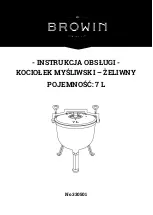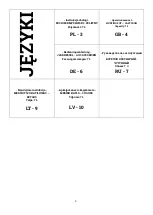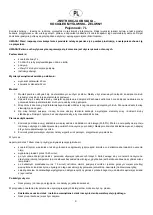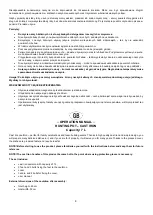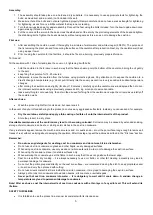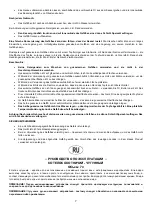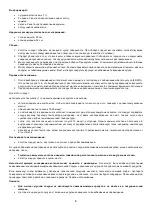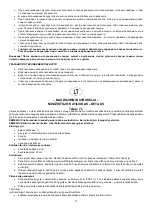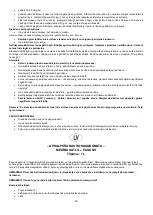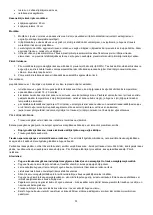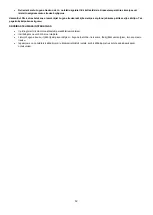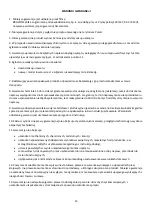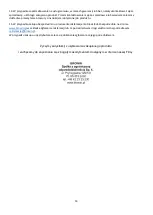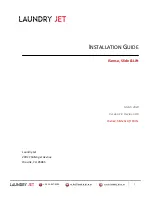
5
Assembly:
1.
The assembly should take place on a hardened, dry substrate. It is necessary to use appropriate tools for tightening the
bolts: a screwdriver and a wrench (not included in the set).
2.
Make sure that all the bolts and nuts are tightened properly! Remain careful and do not use excess strength for tightening
for tightening, as cast iron is a brittle material that is prone to cracking.
3.
Turn the bowl upside down for easier assembly. Connect the feet using the bolts included. Turn the bowl upside down once
again, making it stand on the feet.
4.
Put the cover and the arm onto the bowl. Hook the side bands of the arm by the protruding elements of the bowl and tighten
the stabilising bolts. Tighten the bowls manually, without using excess force, so as not to damage the cast iron.
First use:
1.
After assembling the cauldron, wash it thoroughly in a mixture of warm water and white vinegar (50/50%). The purpose of
that is removing the plant oil used for securing the surface of the cauldron after production. Next, dry the cauldron well, best
using a paper towel.
2.
Prior to using the cauldron for the first time, it should be fired in a burning, previously prepared furnace.
To this end:
fill the cauldron with 1 litre of oil and place the cover on it, tightening it with bolts;
hold the cauldron in the furnace in such a way that the flames heat up only the bottom of the cauldron, brining the oil gently
to the boil;
keep firing the cauldron for 15-20 minutes;
afterwards, remove the cauldron from the furnace using protective gloves. Pay attention not to expose the cauldron to a
drastic change in temperature (e.g. do not put it directly into the snow), as cast iron is very sensitive to sudden temperature
changes;
after cooling the cauldron down slightly (for about 10 minutes), carefully open the cauldron cover and spread the hot oil on
the internal cauldron walls using a previously prepared cloth, e.g. wound onto a wooden ladle.
leave everything to cool down fully, then drain the oil used for firing from the cauldron and wipe the oil remains carefully off
the cauldron walls.
After each use:
Wash the product right after it cools down, but never soak it.
In the event of any burnt food adhering to the product, do not use any aggressive surfactants. Instead, you can use sand, for example.
Dry the cauldron carefully and apply a thin coating of edible oil onto the internal walls of the product.
Store the product in a dry place.
Unsuitable maintenance of the cauldron may lead to it becoming corroded.
Corrosion may be caused by extended soaking,
storage of wet cookware in cabinets, or storing acidic dishes in the cast iron cookware.
If any rust stains appear, remove them with a wire scourer, sand, or caustic soda – scour the pot surface long enough to remove all
traces of rust, without worrying about damaging the cauldron. After this stage, repeat the actions described in the “First use” section.
Remember:
Do not use any detergents for washing cast iron cookware and do not wash it in a dishwasher.
Do not use cast iron cookware on glass and other fragile, easily damaged surfaces.
When using cast iron cookware, use only wooden or silicone utensils in order not to damage the cast iron surface.
When using the cookware, place it on stable surfaces only.
When warming the cookware up, set the flame in such a way that it does not go above the lower edge.
Cast iron is unfit for dry cooking – it is always necessary to use oil, butter, or other fat. Heating a meal dry may lead to
permanent damage to cookware.
Do not cut the portion prepared directly on the cast iron surface – we recommend moving the dish to an appropriate vessel
or board, and only then proceed with cutting.
Do not use mixers or electric stirrers inside the cast iron cookware - it may lead to damaging the cast iron surface.
Always put hot cast iron cookware onto wooden boards, silicone mats, or suitable pads.
Never put hot cast iron cookware into water – it is obligatory to wait until it cools down. A sudden change in
temperature may lead to permanent damage to cookware.
Note! After each use, coat the internal walls of cast iron cookware with a thin layer of any edible oil. This will extend its
lifetime.
SAFETY GUIDELINES
It is forbidden to use the product in a manner inconsistent with its intended use.

